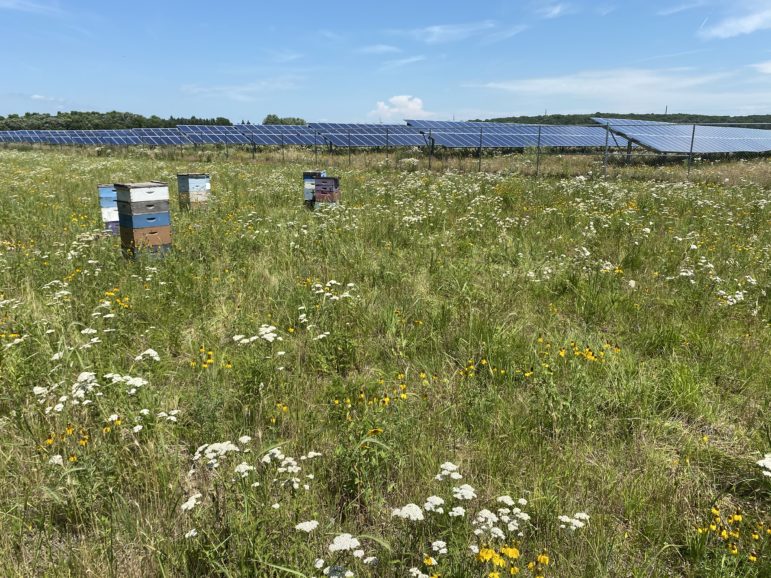
Developer: ENGIE Distributed Solar
Location: 35+ sites across multiple states
Size: >100 MW (>600 acres, sample scorecard)
Vegetation: Natural Resource Services & regional partners
In 2015, ENGIE Distributed Solar launched a program to provide enhanced ecosystem service benefits from the ground cover under and around its solar arrays on arable soils. Today, the company has installed over 100 MW of pollinator-friendly solar projects, spanning over 600 acres across half a dozen states.
ENGIE partners with local land management specialists, such as Natural Resource Services, to seed each site with a regionally customized and diverse mix of roughly 25 different plant species, including grasses, sedges, and flowering forbs native to each region.
“We have pollinator gardens and natural habitat throughout the groundcover of all of our sites in the U.S.,” said Eric Luesebrink, Senior Vice President of Development at ENGIE. “We are committed to renewable energy, and we’re committed to improving the environment in that regard.”
Going back to a 2017 webinar with the National Renewable Energy Lab, ENGIE cites economics as an important factor in their choice to use native vegetation—resulting in reduced overall maintenance costs, improved stormwater infiltration, and minimized soil erosion at its installations. The company is working with NREL on two different studies:
- InSPIRE: Evaluation of the performance of various seed mixes on solar sites to better quantify the economic and environmental impacts of its projects.
- PV-SMaRT: Establishing solar-specific hydrological models showing how deep-rooted ground cover handles stormwater.
A 5 MW ENGIE project in Minnesota was nearly rejected by the Ramsey County Planning Commission after neighbors opposed the project. However, expert testimony about the benefits of pollinator-friendly groundcover—including positive ecological impacts and work opportunities for local seeders and apiarists—convinced two officials to change their votes, securing the project’s passage in a 5-2 decision. The plans and expert testimony on the ground cover prompted one commissioner to say that ENGIE had come to ask for a permit for a solar project and “this feels like we’re getting a free park out of it.”
Minnesota-based Prairie Restorations seeded and manages the site (see the scorecard), noting that a growing number of solar projects they manage will only need a single annual mow.

ENGIE’s pollinator-friendly projects have benefitted local beekeepers as well. In Minnesota, the company partners with Bare Honey to manage apiaries located safely outside the fence of pollinator-friendly solar projects. In Hinesburg, Vermont, the company hired Bee the Change to plant vegetation and install a beehive at its 1.67 MW Magee Hill solar farm. Today, Bee the Change sells honey and beeswax harvested from Magee Hill and other solar sites in the state as well as harvesting milkweed fluff to use as insulation in neckwarmers.
Bee the Change has witnessed an increase in pollinator abundance at the solar sites where it works. During an initial 15-minute survey, company founder Mike Kiernan has recorded anywhere from 6 to 37 unique pollinators at any given site. However, three years after seeding the lands with pollinator-friendly plants, those numbers grow into the mid 200-range.
“By the end of year three, you can create a pollinator habitat equivalent to the most beautiful meadow you’ve ever walked through in the peak of summer. And it has impacts beyond the fence-lines,” says Kiernan.
In the largest study of its kind to date, Rutgers University found that declining numbers of pollinators have been negatively affecting crop yields. However, in Vermont, the farmer who leased 11 acres of his land in Hinesburg to Encore Renewables for the ENGIE Distributed Solar project said his apple trees hadn’t produced so much fruit since he was a child.

